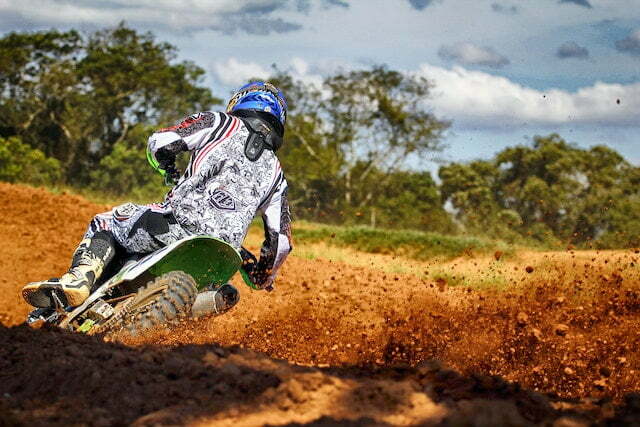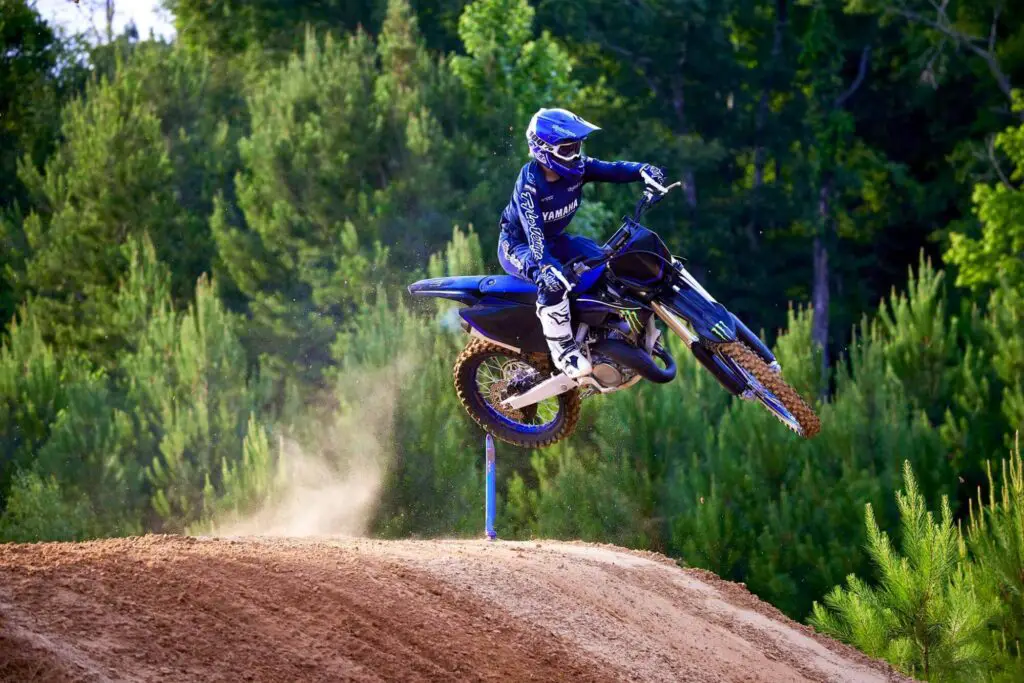If you’re new to dirt biking (or to the world of powersports in general), you might be wondering “what does CC mean in dirt bikes?”.
Well, you’re in luck, because this whole article is dedicated to answering your question.
In dirt bikes, “CC” refers to the engine displacement, which is the volume of the engine’s cylinders. CC stands for “cubic centimeters” and is used as a measurement of the engine’s size and power. The higher the CC, the larger the engine and the more power it is capable of producing.
For example, a dirt bike with a 250cc engine will generally have less power than a dirt bike with a 450cc engine.
CC is a common specification used to compare and classify different dirt bike models based on their engine size and power output.
How Does CC Impact Dirt Bike Performance
The CC or engine displacement plays a significant role in determining the performance of a dirt bike.
Cars are similarly classified by their engine size, but it is measured in liters instead (e.g. 2015 Chevrolet Impala has a 2.5-liter engine).
A higher CC engine typically produces more power, acceleration, and speed than a lower CC engine.
This means that a dirt bike with a higher CC engine will generally have more torque and horsepower, allowing it to handle more challenging terrain and obstacles with greater ease.
On the other hand, a lower CC engine will be lighter and more agile, making it easier to maneuver on tight trails or in technical sections.
It is important to note that CC is not the only factor that affects a dirt bike’s performance, as other factors such as the engine configuration, weight, and suspension also play a crucial role.
Ultimately, choosing a dirt bike with the appropriate CC engine depends on the rider’s skill level, riding style, and intended use of the bike.
Types of Popular Dirt Bikes by CC Range
Dirt bikes come in various sizes and engine capacities, categorized by their CC (cubic centimeters) range.
Here are some types of popular dirt bikes by CC range:
50cc
These are typically smaller bikes designed for children and young riders.
They are easy to ride, lightweight, and perfect for beginners who are just learning to ride.
110cc to 125cc
These bikes are slightly larger than the 50cc models and are suitable for young adults or beginners who want a bit more power and speed.
They are easy to handle, and some models can be used for racing.
250cc
These bikes are a popular choice for intermediate riders and are suitable for off-road and trail riding.
They are capable of more speed and power and are designed for riders who want more of a challenge.
450cc
These are the largest and most powerful dirt bikes and are designed for experienced riders who want to race or tackle difficult terrain.
They are capable of high speeds, and acceleration, and have a lot of torque.
Please note that these are just general categories, and different models may have different specifications and features.
You should choose a dirt bike based on your skill level, intended use, and personal preferences, and always wear appropriate safety gear when riding.
Understanding Compression Ratios in Dirt Bikes

Compression ratio is a crucial specification in dirt bikes that affects the engine’s performance and power output.
The compression ratio refers to the ratio of the volume of the cylinder when the piston is at the bottom of its stroke (BDC) to the volume of the cylinder when the piston is at the top of its stroke (TDC).
A higher compression ratio means that the fuel-air mixture is compressed more before ignition, resulting in a more powerful explosion in the cylinder, which generates more power.
However, high compression ratios also mean that the engine is more prone to knocking, which can cause damage to the engine.
For this reason, dirt bike manufacturers carefully design their engines to balance compression ratio with other factors such as fuel octane rating, engine cooling, and ignition timing.
It is important to understand the compression ratio of your dirt bike and how it affects performance, as this can influence the bike’s power delivery, fuel efficiency, and overall durability.
You can find information on your bike model compression ratio in your owner’s manual or by searching online.
Tips for Maintaining Your Engine’s Power Output
While we’re on the topic of engines and power output, let’s touch on a few handy tips about maintaining that power output.
Change the oil regularly
Changing the oil is one of the most critical maintenance tasks for keeping your engine running smoothly.
Dirty or old oil can reduce power output and increase wear and tear on the engine.
Follow the manufacturer’s recommendations for oil change intervals and use a high-quality oil designed for dirt bikes.
Replace the air filter
A clogged air filter can reduce airflow to the engine, reducing power output.
Check the air filter regularly and replace it when it becomes dirty or clogged.
Maintain the cooling system
Dirt bikes generate a lot of heat, and the cooling system is essential for preventing overheating and maintaining power output.
Check the coolant level and inspect the radiator and hoses for leaks or damage (learn about motorcycle vs car coolant).
Check the spark plug
The spark plug is responsible for igniting the fuel-air mixture in the engine, and a dirty or worn spark plug can reduce power output.
Check the spark plug regularly and replace it when it becomes dirty or worn.
Keep the carburetor clean
The carburetor is responsible for mixing fuel and air and delivering it to the engine.
A dirty or clogged carburetor can reduce power output and cause engine problems.
Clean the carburetor regularly and follow the manufacturer’s recommendations for maintenance.
Here’s a link to our dirt bike carburetor guide.
Conclusion
So, we started this article by defining CC or engine displacement, which plays a significant role in determining a dirt bike’s performance, with higher CC engines generally producing more power, acceleration, and speed.
We also talked about compression ratio, which refers to the ratio of the volume of the cylinder when the piston is at the bottom of its stroke to the volume of the cylinder when the piston is at the top of its stroke, and how it affects engine performance.
Then we explored the different types of popular dirt bikes by CC range, ranging from smaller bikes designed for children to larger and more powerful bikes suitable for experienced riders.
Finally, we provided some tips for maintaining your engine’s power output, such as changing the oil regularly, replacing the air filter, maintaining the cooling system, checking the spark plug, and keeping the carburetor clean.
I hope you now have a much better understanding of your dirt bike’s CC specification and can show off your knowledge in front of your dirt bike buddies.



